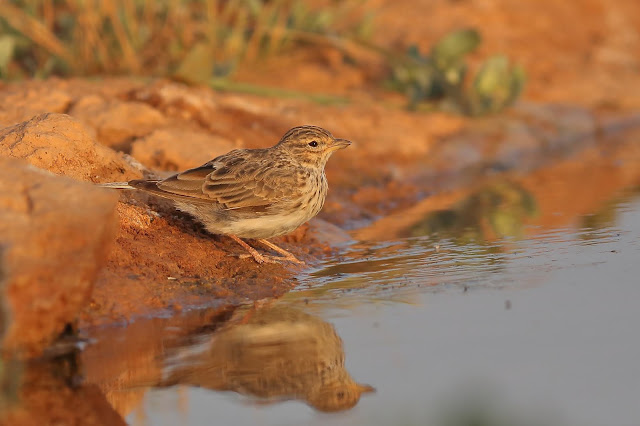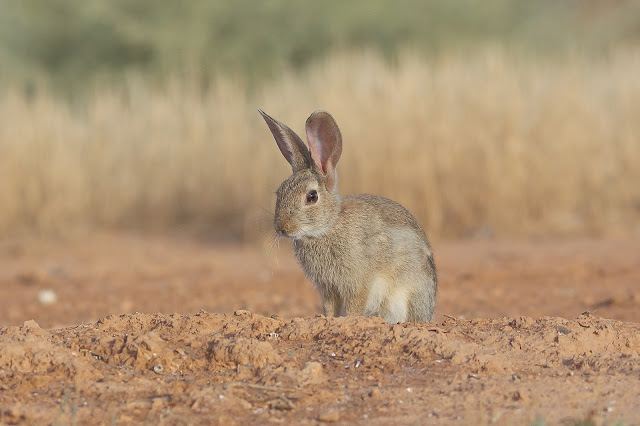Hola una vez más.
Hi again.
Hi again.
En el siguiente enlace podéis ver nuestros próximos viajes fotográficos y de observación de aves y mamíferos nacionales y al extranjero. Espero que os gusten y os animéis a venir conmigo. Una experiencia que nunca olvidareis.
In the following link you can see our next national and foreign Birds and Mammals photographic and observation trips. I hope you like them and I encourage you to come with me. An experience that you will not forget.
Este blog es sobre algunas de las fotos que pude tomar en un hide para Gangas en la provincia de Zaragoza a finales del mes de julio.
This post is about some photos that I was able to take in a hide for Sandgrouse in the province of Zaragoza at the end of July.
Como os decía, a finales de julio tuve un cliente extranjero que quería un viaje a la carta y me ocupé de el durante 7 días. En la lista de las especies que me mandó para fotografiar estaban 5 especies que las podíamos conseguir en este hide. Le organicé el viaje y le lleve hasta él. El resto de los días fueron por la comunidad de Madrid y Castilla La Mancha, pues las otras especies estaban en estas dos comunidades.
As I was saying, at the end of July I had a foreign client who wanted an à la carte trip and I took care of him for 7 days. In the list of species that he sent me to photograph there were 5 species that we could get in this hide. I organized the trip for him and I drove him to it. The rest of the days were through the community of Madrid and Castilla La Mancha, as the other species were in these two communities.
De todas las especies que quería fotografiar en su viaje, estas eran as 5 seleccionadas en este día:
Of all the species that he wanted to photograph on his trip, these were the 5 selected on this day:
Terrera común (Calandrella
brachydactyla).
Greater Short-toed
Lark.
Terrera marismeña (Calandrella
rufescens).
Lesser
Short-toed Lark.
Calandria común (Melanocorypha
calandra).
Calandra
Lark.
Perdiz roja (Alectoris
rufa).
Red-legged
Partridge.
Y ganga ibérica (Pterocles
alchata).
Pin-tailed
Sandgrouse.
Os enseño algunas fotos más que creo que todo lo que vimos es muy bonito y merece la pena enseñároslo mejor y con más detalle.
I show you some more photos that I think all we saw is very beautiful and it is worth showing it to you better and in more detail.
Terrera común (Calandrella
brachydactyla). Tiene una longitud de 13-14 cm, es estival y en España se distribuye en el interior peninsular, la franja costera suroriental y en Baleares. El invierno lo pasa en el Sahel.
Greater Short-toed
Lark. It is 13-14 cm long, it is a summer visitor and in Spain it is distributed in the interior of the peninsula, the southeastern coastal area and in the Balearic Islands. It Winters in the Sahel.
Terrera marismeña (Alaudala
rufescens). Tiene una longitud de 12-13 cm y es sedentaria. En la Península (subespecie apetzii) se la puede encontrar en cuatro núcleos principales: la depresión del Ebro, sureste peninsular, la franja atlántica de Andalucía y La Mancha. Hay dos subespecies endémicas de las islas Canarias, la de Tenerife (rufescens) y la polatzeki que habita Gran Canaria, Lanzarote, Fuerteventura y el archipiélago Chinijo.
Lesser
Short-toed Lark. It is 12-13 cm long and sedentary. In the peninsula (subspecies apetzii) it can be found in four main nuclei: the Ebro depression, the southeast of the peninsula, the Atlantic strip of Andalusia and La Mancha. There are two subspecies endemic to the Canary Islands, Tenerife (rufescens) and Polatzeki that inhabit Gran Canaria, Lanzarote, Fuerteventura and the Chinijo archipelago.
Se parece a la especie anterior pero fijaros, entre otras características, que tiene el pecho muy barrado como mayor diferencia para su identificación.
It resembles the previous species but note, among other characteristics, that it has a very barred chest as the greatest difference for its identification.
Perdiz Roja (Alectoris
rufa). Es una ave rechoncha de 32-34 cm de longitud, sedentaria y, como podéis apreciar, de bonitos colores. En España está ampliamente distribuida, siendo más abundante en el centro y sur peninsular t más escasa en el litoral mediterráneo y la cornisa cantábrica. También está presente en Baleares y Canarias, si bien se cree que las de Canarias haya podido ser introducidas. Rara vez se la encuentra en zonas de alta montaña por encima de los 1.500 a 1.800 metros de altitud.
Red-legged
Partridge. It is a chubby bird 32-34 cm long, sedentary and, as you can see, beautifully colored. In Spain it is widely distributed, being more abundant in the center and south of the peninsula and more scarce on the Mediterranean coast and the Cantabrian coast. It is also present in the Balearic and Canary Islands, although it is believed that the Canary Islands specimens may have been introduced. It is rarely found in high mountain areas above 1,500 to 1,800 meters of altitude.
Calandria común (Melanocorypha
calandra). Esta ave es de mayor tamaño que las terreras alcanzando una longitud de 18-19 cm y es una especie residente pero en invierno hacen grandes agrupaciones de comportamiento nómada. En España se haya ampliamente distribuida por el centro peninsular, el valle del Ebro, Extremadura y el valle del Guadalquivir. No se encuentra en los sistemas montañosos, la franja cantábrica, Baleares y Canarias.
Calandra
Lark. This Bird is larger than Short-toed Lark reaching a length of 18-19 cm and it is a resident species but in winter they make large groups of nomadic behavior. In Spain it is widely distributed in the center of the peninsula, the Ebro valley, Extremadura and the Guadalquivir valley. It is not found in the mountainous systems, the Cantabrian strip, the Balearic Islands and the Canary Islands.
También acudieron a beber dos conejos comunes (Oryctolagus cuniculus).
Two Common Rabbits also came to drink.
Cogujada común (Galerida
cristata). Es un ave sedentaria de mediano tamaño alcanzando los 18cm de longitud. Está ampliamente distribuida por la Península Ibérica a excepción de la cornisa cantábrica, la mayor parte de Galicia, montes vascos y pirineos. Tampoco vive en Canarias ni Baleares.
Crested
Lark. It is a medium-sized sedentary Bird reaching 18cm in length. It is widely distributed throughout the Iberian Peninsula except for the Cantabrian coast, most of Galicia, the Basque mountains and the Pyrenees. Nor does he live in the Canary Islands or the Balearic Islands.
Ganga ibérica (Pterocles
alchata). Ave esteparia, compacta, corpulenta y estacionaria que puede llegar a medir 39 cm de longitud. En la Península Ibérica se distribuye en 5 núcleos poblacionales: la meseta norte, Valle del Ebro, Extremadura, meseta sur y las marismas del Guadalquivir. Tienen un acusado dimorfismo sexual. El ejemplar de la imagen es un macho.
Pin-tailed
Sandgrouse. Steppe Bird, compact, stout and stationary that can measure up to 39 cm in length. In the Iberian Peninsula it is distributed in 5 population centers: the northern plateau, the Ebro Valley, Extremadura, the southern plateau and the Guadalquivir marshes. They have a marked sexual dimorphism. The specimen in the image is a male.
Son muy bonitas y aunque en las fotos se les ve con muchos colores son muy miméticas y difíciles de ver en los campos.
They are very beautiful and although in the photos they are seen with many colors they are very mimetic and difficult to spot in the fields.
Al ser aves granívoras, necesitan beber regularmente, por lo que se acercan a las charcas por la mañana y por la tarde para saciar su sed.
As they are granivorous Birds, they need to drink regularly, so they come to ponds in the morning and in the afternoon to quench their thirst.
Sus pollos, aunque son nidífugos, no pueden volar bien hasta los dos meses de edad y habitualmente se encuentran muy alejados de las fuentes de agua. La solución para darles de beber consiste en mojar las plumas de su vientre que son muy absorbentes y así poder dar de beber a su prole. En la foto un macho llenando su plumas de agua.
Their chickens, although they are nidifugal, cannot fly well until they are two months of age and are usually very far from water sources. The solution to give them to drink is to wet the feathers of their belly that are very absorbent and thus be able to give their offspring to drink. In the photo a male filling his feathers with water.
Hembra.
Female.
Un zorro común (Vulpes vulpes) también vino a saciar su sed.
A Red Fox also came to quench its thirst.
Ganga ortega (Pterocles
orientalis). Ave esteparia, compacta, corpulenta y estacionaria que puede llegar a medir 36 cm de longitud. En España está presente en las islas de Fuerteventura y Lanzarote y dentro de la Península Ibérica hay siete núcleos poblacionales: la meseta norte, el valle del Ebro, los páramos del Sistema Ibérico, Extremadura, la meseta sur, el valle del Guadalquivir y el sureste árido. Al igual que la especie anterior tiene un acusado dimorfismo sexual. En la foto un macho.
Black-bellied
Sandgrouse. It is a compact, stout and stationary steppe Bird that can measure up to 36 cm in length. In Spain it is present on the islands of Fuerteventura and Lanzarote and within the Iberian Peninsula there are seven population centers: the northern plateau, the Ebro valley, the páramos of the Iberian System, Extremadura, the southern plateau, the Guadalquivir valley and the southeast arid. Like the previous species, it has a marked sexual dimorphism. In the photo a male.
Lo dicho anteriormente de las gangas ibéricas (Pterocles
alchata), en cuanto a su necesidad de beber regularmente y el acarreo de agua en las plumas del pecho para dar de beber a sus pollos, es aplicable también a esta especie.
The aforementioned of the Pin-tailed
Sandgrouse, regarding their need to drink regularly and carrying of water in their breast feathers to give their chicks to drink, is also applicable to this species.
Hembra.
Female.
Si queréis suscribiros a este blog de los viajes que hacemos pincha en el siguiente enlace: Suscribirse y haz clic en ¿Quieres suscribirte a nuestro blog?
If you want to subscribe to this post about the trips we do, click on the following link: Susbcribe and click on: Do you want to subscribe to our blog?
Espero que os haya gustado y hasta pronto.
I hope you like it and see you soon.





















































Como nos tienes habitualmente acostumbrados, magnífico reportaje y fotos increíbles de las gangas y las ortegas.
ResponderEliminarUn fuerte abrazo
Pepe
Muchas gracias Pepe.
EliminarCelebro que te hayan gustado.
Un abrazo,
Luis Sitges